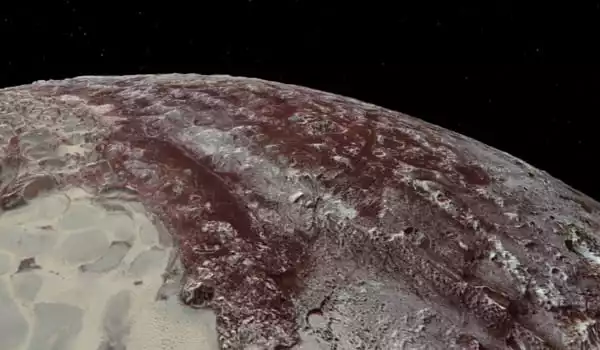Pluto’s atmosphere, which is already thin, is mostly nitrogen with a few dabs of methane and carbon monoxide. As surface temperatures fall, it appears that nitrogen is freezing up again, causing the atmosphere to fade.
The assessment was made using occultation, which involves using a distant star as a backlight for telescopes on Earth to look at what’s going on Pluto. It’s a tried-and-true observation method widely used in astronomy.
When Pluto passed in front of a star on the night of August 15, 2018, a team of astronomers led by the Southwest Research Institute set up telescopes at various locations across the United States and Mexico to observe Pluto’s atmosphere as it was briefly back-lit by the well-placed star. This occultation event was used by scientists to measure the overall abundance of Pluto’s tenuous atmosphere, and they discovered compelling evidence that it is beginning to disappear, refreezing back onto its surface as it moves further away from the Sun.
The central flash seen in 2018 was by far the strongest that anyone has ever seen in a Pluto occultation. The central flash gives us very accurate knowledge of Pluto’s shadow path on the Earth.
Dr. Eliot Young
It took about two minutes for Pluto’s atmosphere and solid body to pass in front of the star, during which time the star faded from view. The density profile of Pluto’s atmosphere was determined by the rate at which the star vanished and reappeared.
“Scientists have used occultations to monitor changes in Pluto’s atmosphere since 1988,” Dr. Eliot Young, a senior program manager in SwRI’s Space Science and Engineering Division, explained. “The New Horizons mission obtained an excellent density profile from its 2015 flyby, consistent with Pluto’s bulk atmosphere doubling every decade, but our 2018 observations do not support that trend.”
Several telescopes stationed near the center of the shadow’s path observed a phenomenon known as a “central flash,” which is caused by Pluto’s atmosphere refracting light into a region at the shadow’s very center. When measuring the occultation of an object by an atmosphere, the light dims as it passes through the atmosphere and gradually returns. This results in a moderate slope at both ends of the U-shaped light curve. Refraction by Pluto’s atmosphere caused a central flash near the center of its shadow in 2018, transforming it into a W-shaped curve.

“The central flash seen in 2018 was by far the strongest that anyone has ever seen in a Pluto occultation,” Young said. “The central flash gives us very accurate knowledge of Pluto’s shadow path on the Earth.”
Pluto’s atmosphere, like Earth’s, is mostly nitrogen. Pluto’s atmosphere, unlike Earth’s, is supported by the vapor pressure of its surface ices, which means that small changes in surface ice temperatures would result in large changes in the bulk density of its atmosphere. Pluto takes 248 Earth years to complete one full orbit around the Sun, and its distance from the Sun varies from 30 astronomical units (1 AU is the distance from the Earth to the Sun) to 50 AU.
Pluto has been receiving less and less sunlight as it moves further away from the Sun for the past quarter-century, but its surface pressure and atmospheric density have continued to rise until 2018. This was attributed to a phenomenon known as thermal inertia by scientists.
“An analogy to this is how the Sun heats up sand on a beach,” said SwRI Staff Scientist Dr. Leslie Young, who specializes in modeling the interaction of icy bodies’ surfaces and atmospheres in the outer solar system. “The sun is at its brightest at high noon, but the sand absorbs the heat throughout the afternoon, so it is at its hottest in the late afternoon. The continued persistence of Pluto’s atmosphere suggests that stored heat beneath the surface kept nitrogen ice reservoirs on Pluto’s surface warm. According to the new data, they are beginning to cool.”
Sputnik Planitia, a bright glacier that forms the western lobe of the heart-shaped Tombaugh Regio, is the largest known nitrogen reservoir. The data will aid atmospheric modelers in better understanding Pluto’s subsurface layers, particularly compositions that are compatible with the observed heat transfer limits.














